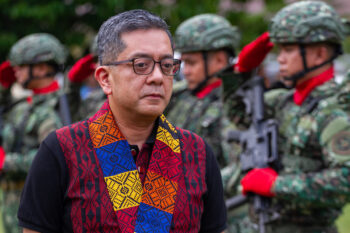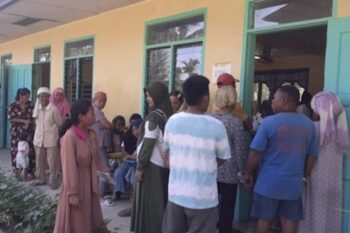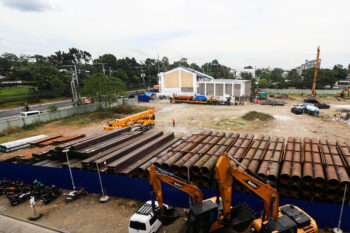NAGA CITY (MindaNews/06 December) — This is that time of the year again for possible unilateral announcements by the Government of the Philippines (GPH) and the National Democratic Front of the Philippines (NDFP) on a Christmas season ceasefire. Last year’s Christmas season ceasefire of 19 days from 16 December 2010 (the traditional beginning of Simbang Gabi or Misa de Gallo) to 3 January 2011 was hailed as the “longest” ever such ceasefire for quite some time. But actually, there were previous longer Christmas season ceasefires of 29 days from 9 December 2001 to 6 January 2002 during the first year of the first Arroyo administration (2001-04), and of 60 days from 10 December 1986 to 6 February 1987, the latter also related to the first GRP-NDFP peace talks during the first year of the first Aquino administration (1986-92). To be sure, a holiday not only from work but also from the fighting would be welcome by most people any time. But it is also time that we go beyond almost ritualistic declarations of a Christmas and New Year ceasefire.
What is really needed by the people now is a bold breakthrough in the current impasse of the GRP-NDFP peace negotiations that are stalled anew (but what else is new?), this time on the issue of the GPH release or non-release of claimed NDFP consultants who are detained. This kind of regular bog-downs on non-substantive agenda matters is already part of the historical pattern of these more-off-than-on negotiations of nearly 20 years since 1992 – a historical pattern of protracted peace negotiations rivaling the prolongation of the protracted people’s war (PPW, and the counterpart counter-insurgency war) of more than 40 years. This pattern has to be decisively broken if there is to be any sustained hope for, including public confidence in, this particular peace process. The GPH and NDFP owe this to the people who they say have “high hopes for the advance of the peace negotiations and the forging of agreements addressing the roots of the armed conflict [through] basic social, economic and political reforms.”
The bold challenge is this: Start the New Year on new footing by hitting the ground running on the general timeframe of 18 months for completing the comprehensive agreements on the remaining items of the substantive agenda, esp. on socio-economic reforms and political-constitutional reforms. This timeframe was already agreed on by the GPH and the NDFP in their Oslo Joint Statement (OJS) of 21 February 2011 when they had resumed their formal peace negotiations after an impasse of almost seven years under the second Arroyo administration (2004-10). Let us hope that we have not stepped on another landmine that may result in another impasse of almost seven years until still another presidential administration in 2016. The said previous impasse (2004-11) was occasioned mainly by the non-substantive agenda issue of the international “terrorist” listing of the Communist Party of the Philippines (CPP), New People’s Army (NPA) and NDFP Chief Political Consultant Jose Maria Sison. That “terrorist” listing issue was never really resolved so far but it certainly did not prevent the resumption of formal talks in February 2011. In fact, it was no longer mentioned therein, at least in the OJS. Nor has it been mentioned as an issue in the current impasse.
This does not mean that the issue of the GPH release of detained NDFP consultants would no longer be discussed as a peace talks agenda matter. Rather it means that the pendency of this issue should not prejudice the peace negotiations on the substantive agenda which, after nearly 20 years, should be already treated with the top prioritization that it deserves, as has been agreed. The Hague Joint Declaration (THJD) of 1 September 1992, the main standing framework document for the GRP(now GPH)-NDFP peace negotiations, indicates that “The substantive agenda of the formal peace negotiations shall include human rights and international humanitarian law, socio-economic reforms, political and constitutional reforms, end of hostilities and disposition of forces.” After completing negotiations on the first substantive item, with the forging of the Comprehensive Agreement on Respect for Human Rights and International Humanitarian Law (CARHRIHL) in 1998, the logical next steps are to complete the negotiations on the three remaining substantive items in the said agenda. These are the top priority issues, not the GPH release of detained NDFP consultants, not the “terrorist” listing of the CPP, NPA and Sison, even though these are also important issues.
The current non-substantive agenda issue of the GPH release of detained NDFP consultants raises, for the NDFP, issues of failure of the GPH to comply with its obligations under existing agreements like the 1995 Joint Agreement on Safety and Immunity Guarantees (JASIG) and of the implications of this failure on the whole peace negotiations, including confidence in the talks and on the GPH’s commitments and capacity to undertake subsequent bigger, as in substantive, obligations. This is already being considered by the NDFP as “just ground to withdraw from the peace negotiations.” For some on the GPH side, not necessarily its peace panel, the issue raises questions about the NDFP’s instrumentalization of the peace negotiations for the mere tactical purpose of securing the release of captured “high value” CPP-NPA cadres, thus “unfairly” negating at the negotiating table what has already been “fairly” gained in the battlefield or war front. Many, if not most, of the claimed NDFP consultants who have been captured do not appear to have track records in the peace negotiations. There are thus questions of sincerity raised by and to both sides, questions about whether they are really sincere in peace negotiations as a mode “to resolve the armed conflict” and for “the attainment of a just and lasting peace,” or whether these are just in the service of a primary war strategy — be it Oplan Bayanihan or the PPW drive towards a strategic stalemate within five years.
The current non-substantive agenda issue of the GPH release of detained NDFP consultants has also moved, in typically super-contentious discussion (bickering is more like it), to the plane of fidelity to or “undermining” of (even “attacking”) their existing agreements esp. THJD, JASIG and CARHRIHL. Take the framework agreement that is THJD. The issue here has to do to with the differing perceptions or understandings of the GPH and the NDFP regarding these general concepts and principles found in paragraph 4 of THJD: “mutually acceptable principles, including national sovereignty, democracy and social justice;” and “the inherent character and purpose of the peace negotiations.” The parties’ subsequent 1994 Breukelen Joint Statement stated, among others, that: “The GRP and the NDF reaffirmed their adherence to The Hague Declaration…. Both sides recognize the need for further discussion on the provisions of The Hague Declaration that will lead to agreements in order to realize the objectives of The Hague Declaration.”
Why not now therefore bring this further discussion straight to the fleshing out or concretization of the three remaining substantive items in the THJD-mandated agenda, rather than go around in circles in an academic-type discussion on abstract general concepts and principles? The idea is to concretize the latter with specific agreed social, economic and political reforms which are, after all, what really count in addressing the roots of the armed conflict. Let this further discussion on specific reforms – not issues like release of NDFP consultants or removal of “terrorist” listing or even the use of landmines – be the litmus test on the sincerity of the parties and on the viability of their peace negotiations. And they have already agreed that this can be done in 18 months or so. So, prove it to the people whom you both invoke. Then we cross the bridge (or the Rubicon) at the end of 18 months.
As there is already an agreed peace talks mechanism of reciprocal working committees (RWCs) and Working Groups for discussion of the three remaining substantive items in the THJD-mandated agenda, the nonetheless important though secondary non-substantive agenda item of release of NDFP consultants, and for that matter other issues on the ground (inc. literally) like the use of landmines, can still be simultaneously addressed or initially processed by an appropriate mechanism, such as most logically and practically the Joint Monitoring Committee (JMC) for the CARHRIHL, so that these do not unduly draw away attention from the substantive talks. The successful resumption of the formal peace negotiations from 15 to 21 February 2011 in Oslo, Norway facilitated by the Royal Norwegian Government (RNG) shows that such negotiations can be held even without yet the release of 13 or so remaining claimed NDFP consultants who are detained (the GPH says it had already released five out of 18 claimed NDFP consultants who have been detained). At that first round of formal talks in Oslo, the NDFP delegation already slightly outnumbered the GPH delegation by 22 to 20. At any rate, the GPH has said that, apart from verification of claimed NDFP consultants by hard photographs as the GPH insists per the 1996 JASIG Supplemental Agreement, it may still undertake releases on the basis of “confidence-building measures” or “humanitarian and other practical reasons,” per the OJS.
In fact, aside from specific measures of goodwill like the release of prisoners and detainees on both sides, the OJS also provided that “To build confidence and create a favorable atmosphere on the occasion of the resumption of the formal talks after more than six years, each Party declared a unilateral, concurrent and reciprocal ceasefire during the formal peace talks from February 15 to 21, 2001.” Now, why can’t this kind of unilateral, concurrent and reciprocal ceasefire be applied to the whole 18 months timeframe for completing the comprehensive agreements on the remaining items of the substantive agenda, which we proposed to be from 1 January 2012 to 30 June 2012? In fine, the peace challenge to the GPH and the NDFP is at least two-fold: [1] produce comprehensive agreements on socio-economic reforms (CASER), on political and constitutional reforms (CAPCR), and on end of hostilities and disposition of forces (CAEHDF) within 18 months; and [2] effect a unilateral, concurrent and reciprocal ceasefire to build confidence and create a favorable atmosphere during the same period of peace negotiations. Contrary to the NDFP position that such a longer than usual ceasefire would “draw attention away from the roots of the armed conflict,” it is the continuing armed hostilities, esp. major incidents and even arrests (witness for example those of CPP high-level cadres from and in Bicol, Sotero Llamas in 1995 and Danilo Borjal in 1996), that ‘draw attention away from’ and often actually disrupt substantive talks on reforms to address those roots. To paraphrase George Santayana, those who cannot remember the past history of the peace talks are condemned to repeat it.
True, there is also the past history of ceasefires to remember like, from the NDFP’s valid perspective, “During the ceasefire talks and ceasefire agreement in 1986 and early 1987, the NDFP personnel and allies were put under surveillance by enemy intelligence. Afterwards, a number of them were arrested, tortured and killed.” But these dangers would appear to be obviated by the scheme of each Party declaring a unilateral, concurrent and reciprocal ceasefire for the period involved, without anymore setting up elaborate ceasefire mechanisms. It is the supposed to be for the effectiveness of long-duration or interim (during peace talks) ceasefires that such mechanisms become necessary, like notably in the GRP/GPH-Moro Islamic Liberation Front (MILF) peace process where the ceasefire is maintained even during the suspension of peace talks. But for the NDFP, there is the paradox that such mechanisms for effective ceasefires are themselves problematic based on their bad 1986-87 experience with them. We are paying much attention to the NDFP perspective on ceasefires because its concerns, issues and points raised about these have to be engaged and addressed. Historically, it is the side that has had to be convinced more to go into whatever ceasefire.
But there appears to be more than just tactical reservations to an interim ceasefire during a reasonable period of peace negotiations. There are definitely strategic considerations on both sides now. For revolutionary forces like the NDFP, a prolonged ceasefire would be counter-productive to the momentum of revolutionary armed struggle as the principal and main form of struggle in a strategy of PPW to the effect the kind of radical social transformation needed to solve the basic problems of the Filipino people. Thus, for the most part, the NDFP has been averse to a ceasefire, esp. a prolonged one. But so has also the AFP for the most part – seeing a ceasefire as not only arresting the momentum of its overall counter-insurgency operation plans (Oplans) but as also providing a respite which the NPA would take advantage of to regroup, regain strength and recover lost ground. Thus, the norm for the GRP-NDFP peace negotiations has been to have no accompanying ceasefire, unlike the case of the Mindanao peace process with MILF and for that that matter the earlier one with the Moro National Liberation Front (MNLF). It is a mode of “fighting while talking.” Is it time for some paradigm shift on that mode on the GRP-NDFP front of war and peace?
We refer to a current paradigm particularly on the NDFP side that usually or generally views ceasefire not so much as among “specific measures of goodwill and confidence-building to create a favorable climate for peace negotiations” (except in the OJS but for only one week, during the first round of resumed formal talks) but instead more as a form of “end of hostilities and disposition of forces” that should come only last, at the end of successful peace talks, if it comes to that, per the agenda framework of THJD. Thus, to talk of a prolonged, indefinite or permanent ceasefire at the current juncture would be, for the NDFP, tantamount to premature laying down of arms, surrender or capitulation to the class enemy. This shows how important continuing armed struggle is to the NDFP. Aside from the NDFP’s overarching PPW strategy adverted to above, continuing armed struggle is also seen by it as necessary pressure to keep the GRP honest, not drag its feet, in the peace talks and then as insurance in case these talks collapse. As they have for several times, inc. notably in early 1987 under the first Aquino administration which shortly thereafter declared a “total war” against the NPA.
There is also a question of sincerity or serious engagement in the peace talks involved here. While continuing armed struggle (thus, non-ceasefire) is seen by the NDFP as necessary pressure to keep the GRP honest, not drag its feet, in the peace talks and then as insurance in case these talks collapse, the NDFP might also be asked: does it expect or even intend that the peace talks will collapse, which is why it insists on continuing armed struggle even during peace talks? Is continuing armed struggle “a favorable climate for peace negotiations”? Does it build “goodwill and confidence”? If the warring parties believe that peace negotiations are the way to go and that they have fair prospects of succeeding, then the normal thing to do would be to have an interim ceasefire so that precious and irreplaceable lives – of soldiers, rebels and civilians — will be saved from continuing armed hostilities. If there is going to be an eventual negotiated political settlement anyway, why waste these lives in the meantime? And so, aside from sincerity, there is also a question of the value given to human life. At aanuhin pa nga naman ang damo kung patay na ang kabayo? “A just and lasting peace,” if there will be one, is for the living, not for the dead.
At the same time, peace talks cannot also go on interminably without any results to show such as in terms of various social, economic and political reform measures. Peace talks cannot or should not be, as they are getting to be, as protracted as the armed conflict of four decades. Although most conflict-affected communities, if you ask them, like the Agta tribal folk in the Sierra Madre mountains, would not mind protracted peace talks as long as they are accompanied by a protracted ceasefire. As they would often say, they just want to be left alone by the warring parties to live their lives in peace. Of course, not the “peace of the silenced.”
One arrangement that would be fair enough, even to the revolutionaries, if not to the broad masses of the people, would be to have a reasonable time frame (like say the 18 months agreed in Oslo) for peace talks with an accompanying ceasefire. The consequences of failure of the time-bound peace talks (the “or else…” in our title) would be clear in terms of a return to arms, as a kind of disincentive for failure. Instead of making agreement on a ceasefire dependent on certain progress of the talks like the signing of comprehensive agreements on certain sequential major substantive agenda items (particularly the CASER and CAPCR), the ceasefire can be agreed on first at the start of peace talks and then its (the ceasefire’s) continuation or discontinuation can be made dependent on such progress of the talks or lack of it. In another manner of speaking, this ceasefire is both time-bound and agenda-bound.
But what then does the NPA do during an 18-month ceasefire? Well, it can do what the AFP does, including keeping itself trim and fit, or in fighting form, short of fighting against the other party to the ceasefire. It can also consult its fellow non-state armed group (NSAG) and tactical ally MILF, which is well-versed in the ceasefire mode (since 1998) without losing revolutionary momentum and fighting capacity. And the NPA actually knows quite well that there is so much more that is important that a people’s army can do – including but not limited to the military field — other than military offensives. The NDFP should take a leap of faith too (as the MILF has) in giving the peace talks a chance, albeit within a reasonable time frame – which is not static and which depends on the dynamics and directions of the talks. An interim ceasefire to accompany the talks is not the laying down of arms. In a ceasefire, the force concerned keeps its arms but does not engage in military offensives. It is not “surrender or capitulation.” For the peace-loving people, it is not a “demagogic demand” that “obfuscates the need for addressing the roots of the armed conflict.” The test of the pudding is in the reform merits of the comprehensive agreements negotiated and produced.
The NDFP has actually offered the GPH a “shortcut” of an immediate “truce and alliance on the basis of a general declaration of common intent.” If by the latter, the NDFP means a commitment to what is basically the NDFP 10-point program albeit capsulized, then realistically it should not expect the GPH to hand this to it on a silver platter. Statements of general concepts and principles like “genuine land reform” and “national industrialization” are no longer enough and can be just as subject to “honestly different” interpretations as “national sovereignty, democracy and social justice.” The devil is in the key details of the various possible social, economic and political reform measures. The proposed “general declaration of common intent” can instead more feasibly be a strong commitment to pursue and complete the resumed peace negotiations on the remaining substantive agenda with all due seriousness, focus and deliberate speed within the agreed reasonable timeframe and without undue delays and distractions. This kind of common intent should already suffice to justify a truce or interim ceasefire, even if not yet sufficient to justify an alliance or partnership.
Needless to say, pursuing and more so completing the resumed peace negotiations on the remaining substantive agenda is easier said than done. And more so with a “shortcut” 18-month timeframe. The first substantive agenda item on human rights and international humanitarian law is the easiest of the four substantive agenda items but it took practically the whole six-year term of the Ramos administration from 1992 to 1998 to complete, while its implementation since then up to now has been problematic – and thus should also be addressed by the coming talks. In any case, the parties have shown some flexibility with several schemes for the acceleration of the peace negotiations. And we are also taking a leap of faith, given historical patterns, that they can do it in only 18 months. But if they can agree on the key details even only of land reform, military reform and electoral reform, then they would have done well enough so as to perhaps justify giving them and the process more time for completion and even possible transformation, including the continuation of war “by other means.”
It is still better in the meantime that the parties devote their verbal and written energies to the remaining substantive agenda rather than to their current puerile and belligerent bickering and blame-pointing, like fighting children, on the issue of release of detained NDFP consultants and more lately on who between them has in effect unilaterally “postponed” the peace talks. When one side says that the other side “engages in continuous, vicious, deceptive and even simplistic propaganda attacks,” it can be said to be vice-versa. There is a need to tone down this kind of verbal and written belligerency. Along with the continuing armed hostilities, these only “draw attention away from” or “obfuscate” the substantive issues of the armed conflict. They are counter-productive to “the spirit of encouraging and accelerating the peace negotiations.” (SOLIMAN M. SANTOS, JR. has been a long-time Bicolano human rights and IHL lawyer; legislative consultant and legal scholar; peace advocate, researcher and writer, whose initial engagement with the peace process was in Bicol with the first GRP-NDFP nationwide ceasefire in 1986. He is presently Preesiding Judge of the 9th Municipal Circuit Trial Court (MCTC) of Nabua-Bato, Camarines Sur and Acting Presiding Judge of the Municipal Trial Court (MTC) of Balatan, Camarines Sur.)







